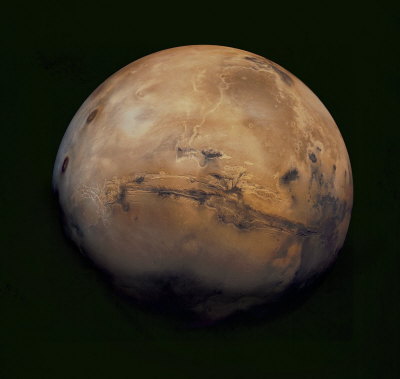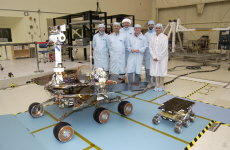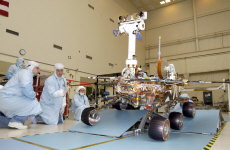What About Mars?
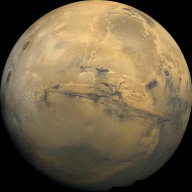
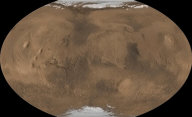
With the Mars Explorer Rovers tooling around on the martian surface, Mars has been in the news a lot lately.
I decided to look some stuff up on Mars that I've probably read before, but somehow over the years it leaked
out of my brain. I suspect my ears are to blame. Actually, most of this stuff was not in the old World Book
Encyclopedia where I did most of my Mars research about 100 years ago.
Mars is flying around the Sun, just like Earth. Well, not JUST like Earth. Mars is a little farther from the
Sun -- an average of 52% farther, at 227,920,000 km. The orbit of Mars is a less round than that of the
Earth. The Earth varies in its distance from the sun by about 4%, while Mars varies 21%.
relorb.gif
Mars is smaller than Earth, a little over half the Earth's diameter. Between that "tootha third" thing they
use in volume calculations and a density 29% less than that of Earth, Mars weighs only 11% as much as Earth.
If I was going to be astronomically and physically correct I would probably refer to Mars's mass instead of
its weight, but I'm not so I didn't. But coincidentally, the mass of Mars is also only 11% as much as the
mass of Earth.
Gravity is on Mars is 38% as strong as Earth's gravity. Maybe this is larger than 11% because of the smaller
diameter of Mars.
It's surprising to me that Mars is that much less dense than earth. Venus and Mercury have densities closer
to Earth's, but the outer planets get less dense.
A compass won't work on Mars because there is no global magnetic field. But there probably used to be
one.
Atmosphere
Mars has air. The martian atmospheric pressure is somewhere .09 to .13 pounds per square inch, or 6.3 to 9
millibars. That's a pretty large fluctuation. It's also a low pressure. That's as much air as you would get
on Earth at an altitude of 110,000 to 120,000 feet. The martian atmosphere is 95% carbon dioxide and 3%
nitrogen. Water makes up 0.02% of the atmosphere.
The air pressure on Mars fluctuates seasonally when the carbon dioxide ice caps at the polar regions sublime
completely (northern summer) or retreat (southern summer). Since there's not much air, the amount that
evaporates in the summer is enough to raise the global air pressure by 25% or so.
Water
There are ice caps on Mars. The southern ice cap stays around all year. It's mainly dry ice -- carbon
dioxide. The northern ice cap has water ice underneath carbon dioxide ice. The carbon dioxide ice of the
northern ice cap evaporates (sublimes) every summer, leaving behind the water ice cap. When the southern ice
cap retreats to its minimum size in the summer, there is only dry ice left on the surface except for a little
water ice along the edge.
On Mars there is quite a bit of water ice in the ground in the polar regions. More than 50% of the
near-surface material is made up of frozen water.
http://marsprogram.jpl.nasa.gov/odyssey/gallery/science/PIA04908.html
There is also frozen water near the surface over the rest of the planet. Most of the area outside the polar
regions has 5%-10% water in the near-surface material.
http://marsprogram.jpl.nasa.gov/odyssey/gallery/science/PIA04907.html
These are estimates from the Odyssey spacecraft that's currently flying around Mars. They use a gamma ray
spectrometer to measure the amount of hydrogen, and from that they get the amount of water.
http://marsprogram.jpl.nasa.gov/odyssey/technology/grs.html
http://marsprogram.jpl.nasa.gov/odyssey/newsroom/pressreleases/20031208a.html
Here's the northern ice cap in early summer:
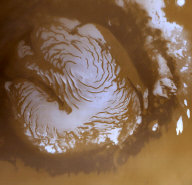
This photo, taken February by the Mars Global Surveyor, shows something that looks like water ice:
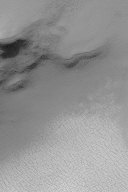
The Global Surveyor has been orbiting Mars since 1998 taking pictures and collecting data. It has taken
several pictures of gullies that were most likely caused by liquid water. Here's one:
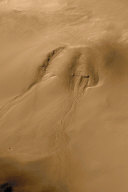
These gullies are on the side of this crater:
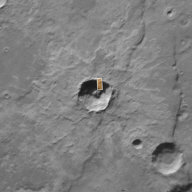
Here are more signs of erosion caused by liquid water on Mars, with explanations:
http://marsprogram.jpl.nasa.gov/mgs/msss/camera/images/june2000/index.html
These gullies were probably caused by water melting underneath a snowpack:
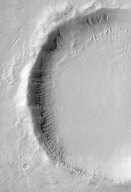
"This visible-light image, taken by Mars Odyssey, indicates that gullies on martian crater walls may be
carved by liquid water melting from remnant snow packs. The gullies in the top right-center appear to emerge
from beneath and within a gradually disappearing blanket of snow. The current snow pack in this crater
appears to remain only on the cold, pole facing crater wall (top). On the less-shaded, warmer sides of the
crater (left), the snow cover has completely disappeared, leaving the gullies exposed. The image shows an
area 14.8 kilometers (9.2 miles) by 21.6 kilometers (13.4 miles). North is toward the top, and illumination
is from the left."
Here's another, from Global Surveyor:
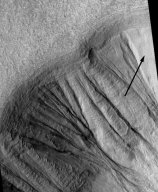
"This image, taken by Mars Global Surveyor spacecraft, shows gullies on martian crater walls that may be
carved by liquid water melting from remnant snow packs. Numerous gullies are seen, with a remnant of the snow
pack (arrow) proposed to be the source of water that eroded the gullies. This Mars orbiter camera image
(number M09-2875) covers an area of 2.8 kilometers (1.7 miles) by 4.5 kilometers (2.8 miles) and is located
at 33.3 degrees south, 92.9 degrees east. North is toward the top, and illumination is from the left."
There might be liquid water on Mars today about 500 meters below the surface, but it's too cold and there's
too little air pressure for liquid water on the surface today.
Here are a couple of papers on martian water:
hend.mola.pdf
1080497v1.pdf
This picture from the Mars Rover Opportunity last Saturday. It looks like a water run-off, but it probably
just looks that way.
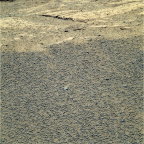 Weather
Weather
It's cold on Mars! The average surface temperature is cold, anyway, at -81F (-63C).
| |
Minimum |
Maximum |
| Polar Night |
-199F (-128C) |
|
| Equatorial Day |
|
80F (27C) |
| Pathfinder |
14F (-10C) |
-105F (-76C) |
| Mars Exploration Rover Est. |
32F (0C) |
-148F (-100C) |
The maximum temperature is around 98F (37C) and the minimum is around -190F (-123C). These are pretty extreme
cases. The Mars Pathfinder recorded temperatures at its landing site between 14F (-10C) and -105F (-76C).
There is a big daily fluctuation because of the thin air.
There are clouds and snow on Mars, but the snow is dry ice (carbon dioxide) instead of water ice.
http://tharsis.gsfc.nasa.gov/snow_paper.html
The wind on Mars can blow up to 80 mph, but because the air is so thin there it doesn't push dust,
spacecraft, and bicycles nearly as hard as an 80 mph wind does on earth. But the martian wind can generate
giant dust storms.
In 1971, two Soviet spacecraft, Mars 2 and Mars 3, and the U.S. Mariner 9 arrived in orbit around Mars. When
they got there, there was essentially nothing to see because of the huge dust storm raging around the planet.
The dust storm had been obscuring the normally prominent features on Mars for months. Mars 2 and Mars 3 used
film cameras, scanned the file and transmitted that back to Earth. They ran out of film before the storm ran
out of wind. Here's an image from Mars 3:
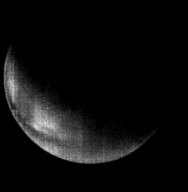
...and one from Mariner 9 on its approach:
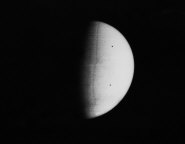
Mariner 9 waited out the storm and got some good pictures after the dust settled. Mariner 9 used a television
camera. Digital cameras were not generally available in 1971. This is a picture of the Olympus Mons, just
like the ones above from Viking and Global Surveyor.
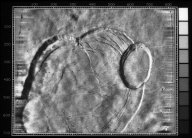 Date and Time
Date and Time
A year on Mars is 687 Earth days long, and 668 martian days long. Because of the orbit of Mars isn't as
circular as Earth's, there is more variation in the length of martian seasons. The martian Summer is 199 days
long, and the Winter is only 146 days.
http://cmex.ihmc.us/data/MarsEssy/seasons/seasons.htm
On Earth, there are Julian Days. That is the number of days since January 1, 4713 BC. That turns out to be a
large number, and is a little hard to remember. So people frequently use the Modified Julian Day (MJD), which
is the number of days since the midnight beginning November 17, 1858. This is 2.4 million and a half days
after January 1, 4713 BC.
Not to be left out, the Martians came up with the Mars Sol Date (MSD), which is the number of martian days
since about Earth noon on December 29, 1873. This beginning date was picked because it was before most of the
technical observations of martian details, and because of some other coincidental times of that date that I
didn't go into enough to understand.
There have been several proposals for Mars month-year calendars, but none have been generally accepted.
For the record, November 23, 2006 is MJD 54062 and MSD 47242. This will be on the test.
What time is it on Mars? It gets a little complicated.
The martian day is exactly about 24 hours. However, martian hours, minutes, and seconds are all about 2.3%
longer than those on earth. I think it was the martians who decided to keep time that way several years ago
so that's how we do it now, rather than having a 24 hour, 39 minute, 35.2 second day.
Before railroads and telegraphs shrank the size of the earth, time was generally kept as "local time" rather
than in time zones. This meant that it was noon whenever the sun was at its peak, and the other 23 hours were
adjusted accordingly. This is one reason that old towns used to have large city clocks. Then they drew lines
separating the earth into time zones of about 15° longitude. That way you didn't have to change your watch
each time the train stopped, and you could arrange to send a telegraph to another town at a certain time
without knowing when the sun peaked there.
NASA and some others use Local Solar Time on Mars sometimes. This makes it easy to see, for example, when a
picture was taken relative to when the sun was highest in the sky. However, Mars wobbles on its axis and
flies around the sun in a less than circular manner, making the Local Solar Noon a little irregular. Mean
Solar Time uses the "average" noon. True Solar Time uses the actual noon. The difference on earth is within
about 14 or 16 minutes. On Mars, it can vary -51 to +40 minutes.
It takes some ciphering to figure out what the true Local Solar Time is. At precisely 10:30 p.m. CDT Tuesday,
May 11, 2004 it was 03:04:46 at the rover Spirit's landing site, and 15:00:45 at Opportunity's landing site.
It's not possible to use a fixed number of seconds to find out what time it will be tomorrow, because using
Local Solar Time the day lengths change.
So we have yet another time to contend with, although this one is easier. The Mission Time for each rover was
set to zero on the Local Solar Midnight before landing. The day was set to zero also. Each mission day has
the average martian day length of 87755.24 earth seconds, so it's easy to compute. They even made some
special slow-running watches for some of the people on the NASA rover teams to use.
At 10:30 p.m. CDT today, the Spirit Mission Time was 02:41:18 on Sol 127. "Sol 127" means the 127th martian
day of the mission. At that time, Opportunity Mission Time was 14:40:08 on Sol 106. The seconds and minutes
on the two mission times are different because they used the Local Solar Midnight for time reference.
Naturally I did all these computations in my head, including the effects of the orbital eccentricity of Mars,
but you can use a program if you need to. Here's a java executable to calculate various martian times and
dates. There's a good explanation of how it's done, too.
Mars24J.zip
Here is some information on martian time:
http://www.giss.nasa.gov/tools/mars24/help/notes.html
Terrain
Mars has some big mountains and valleys. The Olympus Mons is the largest known volcano in the solar system.
It's about 16 miles tall, about three times as high as Mt. Everest. The picture above from Mariner 9 is the
central cauldera from Olympus Mons. Here's one from Viking, taken in 1978:
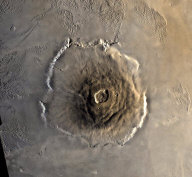
This is a picture of the edge of the Olympus Mons cauldera (the hole in the middle). It's 5 miles across,
taken by Mars Global Surveyor in 2003. You can see a lava flow that was cut off when the cauldera collapsed.
This area is about 12 miles above "sea level" on Mars. Since there's no sea, they use some average base
elevation.
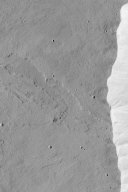
The canyon system of the Valles Marineris is the largest and deepest known in the solar sytem. It's 2500
miles long and up to 6 miles deep:
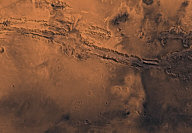 The Moons
The Moons
Mars has two moons, Phobos and Deimos. They're probably asteroids captured by the Mars gravity. Phobos is
only 6.9 miles long, and orbits Mars about 5.5 times per week:
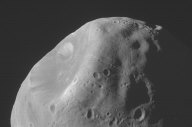

Deimos is even smaller with a length of 3.2 miles. It orbits Mars a little over 3 times per day.
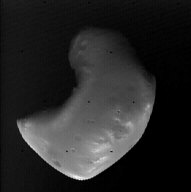
Here are what Deimos and Phobos look like when they fly across the sun. It's not exactly a total eclipse.
http://mars.nasa.gov/mer/gallery/press/opportunity/20040311a.html
History
The U.S.S.R and U.S. started sending things to Mars in 1960. The first six tries didn't work out. The seventh
launch, the 4th by the U.S., was Mariner 4 on November 28, 1964. It made a successful flyby of Mars 8 months
later. The pictures returned by Mariner 4 look really primitive by today's standards:
mariner4
There were less than 25 images returned by Mariner 4, compared to tens of thousands returned by the two Mars
Explorer Rovers in their first year of operation.
In 1969, the same year Apollo 11 made the first moon landing, Mariner 6 and 7 made a Mars flyby. They
returned 75 and 126 images of Mars.
mariner6
mariner7
In 1971, the USSR and US were competing to launch the first vehicle to orbit another planet. The U.S. was
first to launch, with Mariner 8 on a Centaur rocket on May 8. But a few minutes after the launch, the
guidance system failed and Mariner 8 was destroyed, landing in the ocean a few hundred miles northwest of
Puerto Rico.
Then the Soviet Union launched Mars 2 and Mars 3 on May 19 and 28. On May 30, the U.S. launched Mariner 9,
which made it to Mars orbit two weeks before Mars 2 on November 13. Mariner 9 was the first spacecraft to
orbit another planet, even though it was launched after two others headed to the same planet.
Mars 2 and Mars 3 had landers. The Mars 2 lander's retro-rockets didn't fire when they were supposed to, and
it burned up due to a steep entry into the atmosphere.
On December 2, 1971, the Mars 3 lander was the first spacecraft to land on Mars. Here's the official
story:
"The descent module was separated from the orbiter on 2 December 1971 at 09:14 UT. (There is an uncertainty
in the absolute times stated here of about 3 minutes.) Fifteen minutes later the descent engine was fired to
point the aeroshield forward. At 13:47 UT the module entered the martian atmosphere at 5.7 km/sec at an angle
less than 10 degrees. The braking parachute was then deployed, followed by the main chute which was reefed
until the craft dropped below supersonic velocity, at which time it was fully deployed, the heat shield was
ejected, and the radar altimeter was turned on. At an altitude of 20 to 30 meters at a velocity of 60 - 110
m/s the main parachute was disconnected and a small rocket propelled it off to the side. Simultaneously the
lander retrorockets were fired. The entire atmospheric entry sequence took a little over 3 minutes.
"Mars 3 impacted the surface at a reported 20.7 m/s at approximately 45 degrees S, 158 degrees W, at 13:50:35
UT. Shock absorbers inside the capsule were designed to prevent damage to the instruments. The four petal
shaped covers opened and the capsule began transmitting to the Mars 3 orbiter at 13:52:05 UT, 90 seconds
after landing. After 20 seconds, at 13:52:25, transmission stopped for unknown reasons and no further signals
were received at Earth from the martian surface. It is not known whether the fault originated with the lander
or the communications relay on the orbiter. A partial panoramic image returned showed no detail and a very
low illumination of 50 lux. The cause of the failure may have been related to the extremely powerful martian
dust storm taking place at the time which may have induced a coronal discharge, damaging the communications
system. The dust storm would also explain the poor image lighting."
Mariner 9 was more successful and returned 7,329 photos of Mars, Martians, and the surrounding territory.
Here are a few:
mariner9
In 1974 the Soviet Mars 5 spacecraft arrived in Mars orbit. It was to be a communications link for the Mars 6
and Mars 7 landers, which would arrive the following month. Mars 5 lost pressure in its transmitter housing
and failed after 9 days, 22 orbits, and about 60 photos. The Mars 6 lander hit the ground too hard and was
destroyed, and the Mars 7 Lander missed the planet. Here are some pictures from Mars 5:
mars5
In 1975, the U.S. launched Viking 1 and 2, each with an orbiter and lander, arriving at Mars in 1975. The
Viking landers returned data from the martian surface from until 1982 and 1980. The orbiters were active
until 1980 and 1987. 12 years is a long time for a spacecraft to operate in orbit around Mars, especially one
launched in the 1970's.
The Viking spacecraft together returned more than 50,000 photos. Here are 55 of them. Actually, most of these
are a combination of several photos:
viking
After Viking you'd think we have this Mars spacecraft stuff figured out, but since then seven and a half out
of the next 11 launches failed, up to but not including the successful Mars Exploration Rovers currently
wandering around the planet. Here's list of the Mars spacecraft launched to date.
The Pathfinder was the first martian lander with a ground vehicle, although it was pretty small. Here's a
good panorama from Pathfinder that shows the rover.

Here's the Pathfinder rover on Mars:
sol30S55.gif
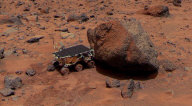
You can browse images from Global Surveyor, Pathfinder, and Odyssey (and most other NASA spacecraft)
here:
http://photojournal.jpl.nasa.gov/PIADetQuery.html
Here are some Mars Express images:
marsexpress
Here is a list of all the Mars missions, successful or not, before 2003:
http://marsprogram.jpl.nasa.gov/missions/log/
Mars "Backgrounder" from NASA:
MarsGlance.pdf
Technical Data for Mars:
http://nssdc.gsfc.nasa.gov/planetary/factsheet/marsfact.html
Updated 12/3/06 (Earth Date)
Back to
xpda.com
Photos Courtesy NASA/JPL-Caltech
